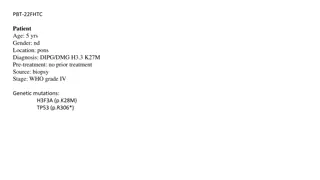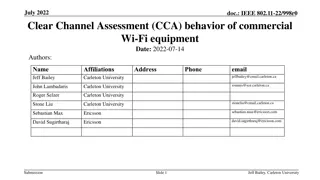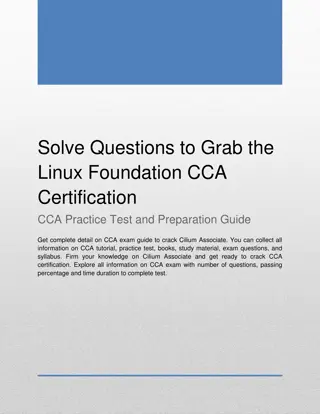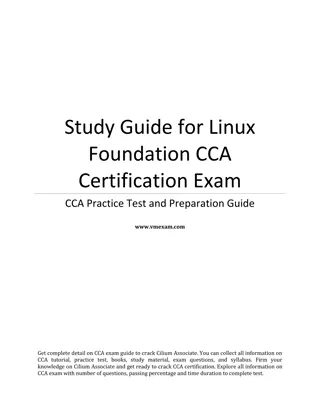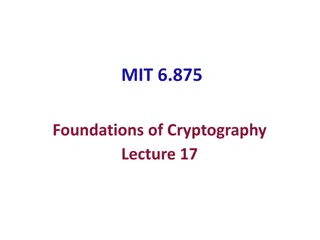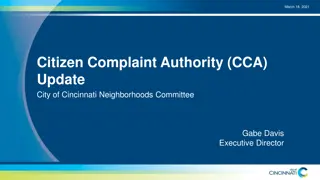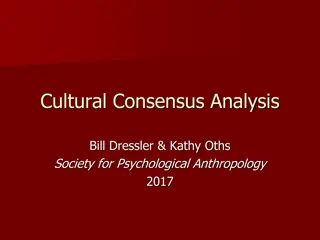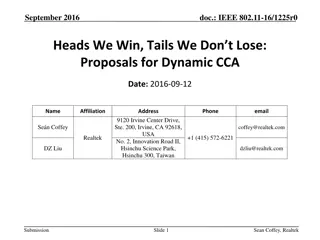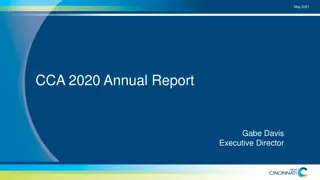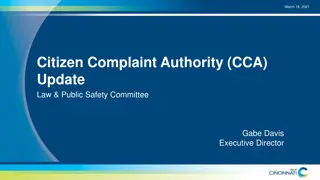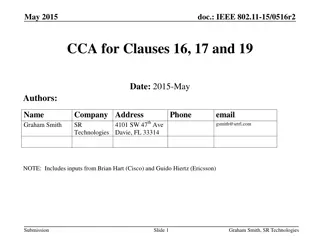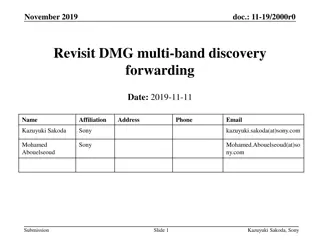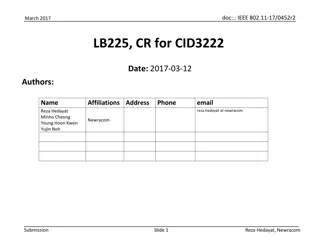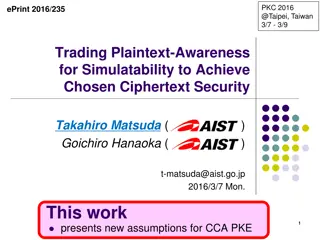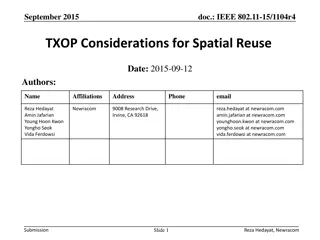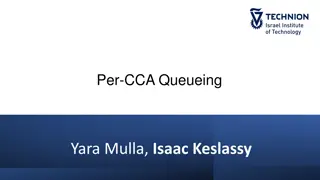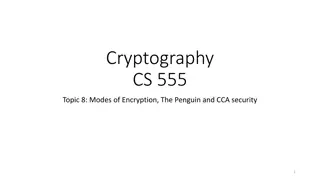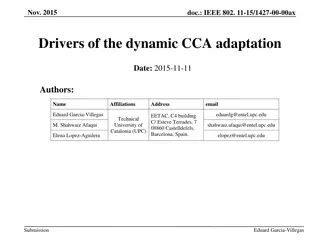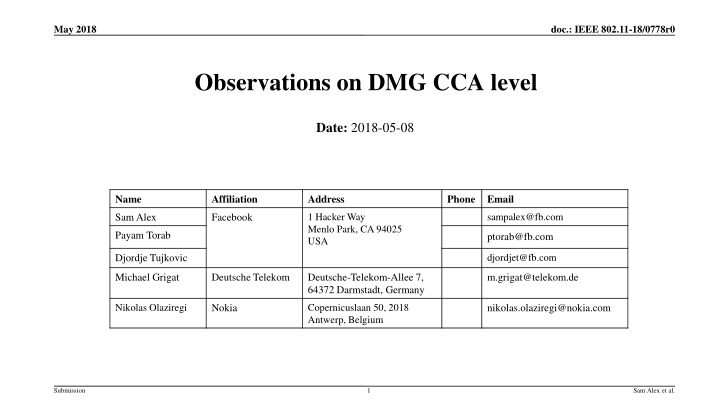
Insights into IEEE 802.11 DMG CCA Levels and Performance
Explore observations on DMG CCA levels in IEEE 802.11 standards, highlighting the impact on directional systems' performance. The discussion covers the implications of current CCA thresholds, modeling medium access performance, and key assumptions for simulation setups.
Download Presentation

Please find below an Image/Link to download the presentation.
The content on the website is provided AS IS for your information and personal use only. It may not be sold, licensed, or shared on other websites without obtaining consent from the author. If you encounter any issues during the download, it is possible that the publisher has removed the file from their server.
You are allowed to download the files provided on this website for personal or commercial use, subject to the condition that they are used lawfully. All files are the property of their respective owners.
The content on the website is provided AS IS for your information and personal use only. It may not be sold, licensed, or shared on other websites without obtaining consent from the author.
E N D
Presentation Transcript
May 2018 doc.: IEEE 802.11-18/0778r0 Observations on DMG CCA level Date: 2018-05-08 Name Affiliation Address Phone Email 1 Hacker Way Menlo Park, CA 94025 USA sampalex@fb.com Sam Alex Facebook Payam Torab ptorab@fb.com djordjet@fb.com Djordje Tujkovic Michael Grigat Deutsche Telekom Deutsche-Telekom-Allee 7, 64372 Darmstadt, Germany m.grigat@telekom.de Nikolas Olaziregi Copernicuslaan 50, 2018 Antwerp, Belgium Nokia nikolas.olaziregi@nokia.com Submission 1 Sam Alex et al.
May 2018 doc.: IEEE 802.11-18/0778r0 Motivation The 802.11ad (and 802.11ay) standards defined the preamble detect (PD) and energy detect (ED) levels in the same manner as 802.11n/ac standard, which is not a directional PHY like DMG Omni directional clear channel assessment (CCA) at minimum sensitivity level (- 68dBm), while providing simple and fair access to the channel, might prevent efficient spatial reuse of the spectrum for directional systems In this presentation we show that the current preamble detect threshold of -68 dBm provides little to no gain, and often times hurts the performance for highly directional systems Submission 2 Sam Alex et al
May 2018 doc.: IEEE 802.11-18/0778r0 CCA levels for Omni and Directional system Omni STA DMG STA Beamformed Omni CCA Omni CCA Omni STA DMG STA DMG STA Preamble detect at MCS 1 receive sensitivity does not mean transmitting can hurt the the neighbor s performance Preamble detect at MCS 1 receive sensitivity means transmitting can hurt the neighbor s performance with similar interference level at the RX Omni system with omni CCA Directional system with omni CCA Submission 3 Sam Alex et al
May 2018 doc.: IEEE 802.11-18/0778r0 Modeling Simple intuitive modeling to get insight into medium access performance of directional systems Methodology o For a given density of users, find the set of users who can transmit simultaneously for different CCA threshold values o Compute the interference caused to each other due to the simultaneous usage of the channel o Compute the link SINR and overall throughput of the system of users Submission 4 Sam Alex et al
May 2018 doc.: IEEE 802.11-18/0778r0 Assumptions (1) Simulation setup o TX nodes are randomly placed in the area and its peer RX are placed such that their link distance is randomized to span up to 10m o Simulation is run on a per link basis CCA complete modeling with propagation 1) Active transmission can trigger CCA at some neighboring STAs (potential interferers), silencing them and stopping them from interfering with desired link 2) The neighboring STAs whose CCAs are not triggered will transmit and cause interference 3) The CCA trigger propagation is accurately modeled by repeating steps (1) and (2), all through the edge of the network Submission 5 Sam Alex et al
May 2018 doc.: IEEE 802.11-18/0778r0 Assumptions (2) Interference and SINR calculation o Interference from TX nodes that were not blocked is added at desired link RX o SINR at each receiver is computed based on the power received through its desired link as well as all interference signals, accounting for TX and RX antenna patterns for all links CCA definitions o Omni directional CCA: The node uses a quasi Omni antenna pattern for performing CCA o Directional CCA: The node uses the same TX antenna pattern that it uses for data transmission for the purpose of CCA o 1wayCCA: Only the TX node performs CCA. CS or CTS to self o 2way CCA: Both TX and RX nodes perform CCA. This models the RTS/CTS mechanism. So the TX power from both the TX and RX of the desired link could trigger CCA on a potential interferer s TX and/or RX, thereby blocking it Note: The nodes blocked by the 2way CCA will be a superset of the nodes blocked by the 1way CCA mechanism Submission 6 Sam Alex et al
May 2018 doc.: IEEE 802.11-18/0778r0 Example of Active and Blocked Nodes Figure shows TX nodes that are blocked and TX nodes that are active Omni directional CCA was used here, so it can be seen that the non-blocked nodes are separated by some minimum distance that correspond to the CCA threshold used (-68dBm) Interferer TX Interferer TX Interferer TX Desired link Desired TX Desired RX Interferer TX Submission 7 Sam Alex et al
May 2018 doc.: IEEE 802.11-18/0778r0 Assumptions Sensitivity (dBm) Spectral Eff. (bps/Hz) SNR reqd (dB) MCS 1 2 3 4 6 7 8 9 -68 -66 -65 -64 -63 -62 -61 -59 -55 -54 -53 0.25 0.5 0.63 0.75 4 6 7 8 9 Parameters o Noise floor = -72dBm o Receiver sensitivity and SNR required based on IEEE 802.11ad spec, assumes 10dB NF and 5dB implementation loss 1 1.25 1.5 1.63 10 11 13 17 18 19 10 11 12 2 2.5 3 Max for P2MP (outdoor) Link distance calculation o Link distance for a class of devices is computed based on EIRP and RX antenna gain of that class. The link distance is limited to the distance that can support the highest MCS. Only path loss is considered here, TX EVM requirements etc. are ignored for now. Plot of link distance with EIRP and RX antenna gain is shown. o With a FCC/ETSI EIRP limit of 40dBm the maximum distances are 300m, 100m and 20m for 36x8, 8x2 and Omni antenna, respectively o For an indoor SRD with 8x2 antenna, an EIRP of 25dB is sufficient to support MCS 12 anywhere within an indoor area of say 10mx10m. EIRP limit (for Indoor) Outdoor Indoor Submission 8 Sam Alex et al
May 2018 doc.: IEEE 802.11-18/0778r0 Simulation scenarios High density scenarios o Indoor (1 user/m2 in a 10m x 10m area) o Outdoor (320 user/km2 in a 250m x 250m area) Various assumptions on antenna capability and CCA applied o Scenario 1: Omni system with Omni CCA o Scenario 2: Direction system with Omni CCA o Scenario 3: Directional system with Directional CCA Submission 9 Sam Alex et al
May 2018 doc.: IEEE 802.11-18/0778r0 Scenario 1A: Omni Antenna with 25dBm EIRP, Indoor For Omni antenna, if CCA is turned off or set to high level, link SINRs degrade and the sum of throughput of all users (sum throughput) suffers significantly In this case, CCA threshold ~ -68dBm and lower provides best performance for 25dBm EIRP with maximum link distance of 10m Submission 10 Sam Alex et al
May 2018 doc.: IEEE 802.11-18/0778r0 Scenario 1B: Omni Antenna with 40dBm EIRP, Indoor With 40dBm EIRP all links are able to attain MCS12 The CCA threshold in this case can increase by 15dB without adverse effects to performance o CCA thresholds of -58dBm or lower gave the best performance. Likewise, if EIRP were reduced bellow 25dBm (especially in power control scenario), we might want to take the CCA level lower Submission 11 Sam Alex et al
May 2018 doc.: IEEE 802.11-18/0778r0 Scenario 2A: 8x2 Array, Omni CCA, 25 dBm, Indoor In directional antenna case, increasing CCA threshold reduces the SINRs achievable per link, but it improves the sum Tput o Instead of very few links hogging the medium, more links can be active contributing to higher spatial capacity and ultimately better spectrum utilization o Same is not possible in Omni scenario Setting the threshold around -48dBm provides the best throughput, despite link SINRs falling below 0dB 10% of the time (high density scenario) Submission 12 Sam Alex et al
May 2018 doc.: IEEE 802.11-18/0778r0 Scenario 2B: 36x8 Array, Omni CCA, 25 dBm, Indoor As directivity further increases, CCA threshold has smaller impact on SINRs, but progressively larger impact to sum throughput This clearly shows a trend that LBT doesn t play beneficial role in high directivity systems o SINRs are 90% of the time above 18dB, and lower CCA thresholds don t improve SINRs as much o In turn, lower CCA thresholds degrade throughput significantly, owing to unnecessary channel back off Submission 13 Sam Alex et al
May 2018 doc.: IEEE 802.11-18/0778r0 Trajectory of SINR and Total Spectrum Efficiency (SE) vs CCA threshold (Indoor scenario) Trajectory of median (50%ile) SINR vs achieved total throughput is shown in the plot As CCA thresholds reduce, all systems approach the single node throughput, i.e. no spatial reuse of spectrum For 8x2 SRD, CCA threshold of -68dBm is not optimal, but -48dBm and above gives the best performance (sum Tput achieved) o Individual per link SINR is not strong enough to meet MCS12 but better overall spectrum utilization is achieved in this case In turn for 36x8 SRD, both increased Tput and no compromise on highest MCS per link is achieved when increasing CCA threshold to -48dBm Single link throughput Submission 14 Sam Alex et al
May 2018 doc.: IEEE 802.11-18/0778r0 Scenario 3: 8x2 array, directional CCA (Indoor scenario) Directional CCA doesn t degrade the trajectory, but only the optimal CCA thresholds may change, as the TX node now has a more telescopic view of the world o Directional CCA applicable to P2P links Directional CCA is slightly superior to Omni CCA, in terms of the sum throughput achievable, provided it is performed at both sides of the link (RTS-CTS) (loss in airtime for transmitting RTS and CTS is not accounted here) Single link throughput Single link throughput 15 Sam Alex et al Submission
May 2018 doc.: IEEE 802.11-18/0778r0 High density Outdoor scenario 20 users (10 links) User density: 320 users/km2 Area: 250x250 m2 EIRP: 40dBm Submission 16 Sam Alex et al
May 2018 doc.: IEEE 802.11-18/0778r0 Trajectory of SINR and Total Spectrum Efficiency (SE) vs CCA threshold (Outdoor scenario) For outdoor scenario, with 40dBm EIRP, we see similar behavior between Omni and directional antennas In this case omni antenna with 40dBm cannot close the link Zoom-in at 36x8 Single link throughput Submission 17 Sam Alex et al
May 2018 doc.: IEEE 802.11-18/0778r0 Density and Spatial Reuse more density values Omni systems, 40dBm EIRP How does the trajectory vary with different user densities (users/km2)? For devices with Omni antenna, as density increases the trajectory varies as follows o At low densities, the best system throughput is achieved at high CCA thresholds, or when CCA is turned off o At mid densities, an optimal point (CCA threshold) is seen where system throughput is maximized o At high densities, CCA thresholds should be set to low values, as the system throughput falls below single link throughput if more than one device starts transmitting Highest achievable Total SE and 50%ile SINR Single link throughput Submission 18 Sam Alex et al
May 2018 doc.: IEEE 802.11-18/0778r0 Density vs Spatial Reuse more density values Directional system with Omni CCA In the case of directional antenna, even at extreme densities (1.6users/m2), higher CCA thresholds provide the better system throughput Single link throughput Submission 19 Sam Alex et al
May 2018 doc.: IEEE 802.11-18/0778r0 Conclusion We showed that the current preamble detect level of -68dBm, which corresponds to MCS1 sensitivity, likely adapted from 2.4/5 GHz omni systems, is very suboptimal from spatial reuse perspective Our study shows that for directional systems with any kind of CCA spatial capacity improves with increasing (relaxing) the CCA (preamble detect) threshold For example, a 10 dB relaxation of CCA level to -58 dBm increases the spatial capacity by 66% We also observe that additional mechanisms such as directional CCA with RTS/CTS results in incremental spatial capacity improvement compared to relaxing the CCA threshold Submission 20 Sam Alex et al
May 2018 doc.: IEEE 802.11-18/0778r0 Straw poll Do you support further study of EDMG CCA level with the goal of relaxing it? o Yes: o No: o Abstain: Submission 21 Sam Alex et al

